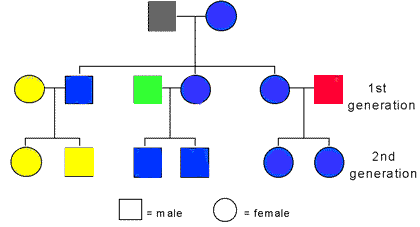
This page was produced as an assignment for an undergraduate course at Davidson College by Jessica Austin under the supervison of Dr. Campbell

 permission
pending
permission
pending
Figure 3 shows inheritance patterns for mtDNA. People with common ancestors (eg. the same mtDNA) are grouped by color. Notice that mtDNA is never passed through the male line, but always through the female line. FBI DNA Analysis
Imagine that the figure above is your family tree. The top circle is your grandmother, one of the middle circles are your mother and her siblings, and the bottom level of the tree is you. For simplification purposes we will assume that you are female, which not only means that you have the exact same mtDNA as your grandmother (the first circle), it also means you will pass the same mtDNA onto your own children.. This is due to the fact that the large size of the egg allows for the retention of mitochondria. While sperm are powered by mitochondria on their way to the cell, as soon as the egg is fertilized by a single sperm, the tail of the sperm breaks off, and along with it the male's mitochondria (Gilbert, 2000). The result is an exclusively female line of inheritance.
The figure above shows two generations extending from a primary female, but imagine that every woman in the world was represented on this tree. The tree would span back thousands of generations, each generation becoming smaller and smaller until finally there was no further back that it could be traced. The woman at the top of such an extensive genealogy has come to be called the "Mitochondrial Eve". The Mitochondrial Eve in the strictest definition is the most-resent shared ancestor of all people living on Earth today that can be traced through matrilineal descent (Cann et al, 1987). The applications of such extensive lineage have several applications in modern science, one of which is the study of ancient DNA or deceased persons in order to assess lineage and even resent relatives.
The sheer number of mitochondria favor the survival of mtDNA in decayed tissues above nuclear DNA over thousands of years. Often only bone fragments are available for analysis; in these fragments mtDNA is more abundant than nuclear DNA, which degrades more rapidly (Hagelberg, 1994). Several Anthropological studies have been done using mtDNA. One of the most famous studies involved the Romanovs, who were direct female descendents Queen Victoria and therefore shared her mtDNA. Anastasia was possibly the most famous member of Romanov family, simply because an individual came forward after the Russian revolution claiming to be Anastasia Ramanov. Modern scientists exhumed the bodies in a mass grave believed to belong to the Ramanovs. Samples were taken from all of the bodies buried there; mtDNA was extracted and used to determine the relation to a common female relative. The study focused on identifying members of the royal family and confirming whether or not a lady claiming to be one of the Romanovs could possibly have been a relative.
MtDNA has also been used to study far more ancient remains such as Neanderthals. The purpose of this study was to establish or negate a genetic link between humans and Neanderthals. Some people believe that mtDNA shows conclusively that no relationship exists between Neanderthals and H. sapiens ( Messer et al, 1997). Another set of controversies arise over the mythical Mitochondrial Eve. Scientists have established that the program used to determine the mathematical existence of the mtEve gives different results depending on how the data is entered, which seems to negate her existence. Other scientists, however, have hypothesized that because mtDNA is prone to random mutations, older populations of mtDNA should have the greatest genetic diversity. This would again point to a common ancestor with origins in Africa.
Click here to see a movie negating the relationship between humans and neanderthals
Click here to read a paper on the debates on human origin.
Click here to read an article negating the relationship between humans and neanderthals